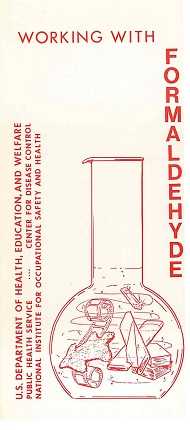Working With Formaldehyde (Revised 1975)
1975
DHHS (NIOSH) Publication Number 74-119

This pamphlet provided information on working with formaldehyde (50000). Topics included properties, uses, hazardous effects of exposure, control of formaldehyde hazards, symptoms, management responsibilities, and employee responsibilities. Formaldehyde has been used as either a liquid solution called formalin or as a powdered granular or flaky material, paraformaldehyde (30525894). Formaldehyde was an irritant to the eyes, nose, mouth and throat. It could on prolonged exposure cause headaches, heart palpitations, and inflammation of the bronchial tubes and lungs. Death could result from swelling of the vocal cords. Damage to the digestive system, kidneys and central nervous system would follow swallowing of formalin solution. Skin contact could result in dermatitis. High concentrations of formaldehyde presented an explosion hazard. Enclosures around processes where formaldehyde is used should be installed where feasible and adequate local and general exhaust ventilation should be employed. Workers should wear safety goggles, gloves and protective clothing. Fullface respirators or canister type gas masks can be used for emergency protection. No employee with a history of asthma or other allergic sensitivity or a history of skin disorders should be assigned to an area where contact with formaldehyde is likely to occur.
- Page last reviewed: March 29, 2017
- Page last updated: March 29, 2017
- Content source:
- National Institute for Occupational Safety and Health Education and Information Division


 ShareCompartir
ShareCompartir